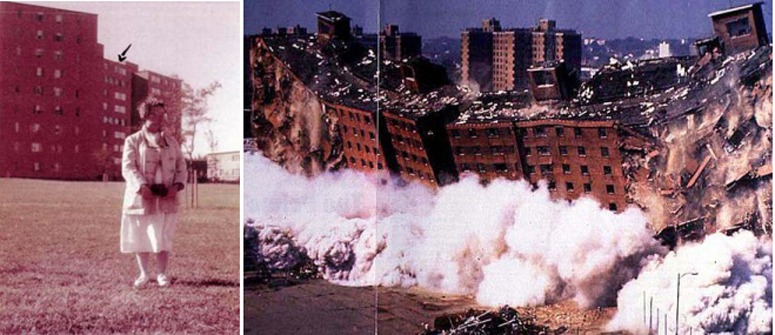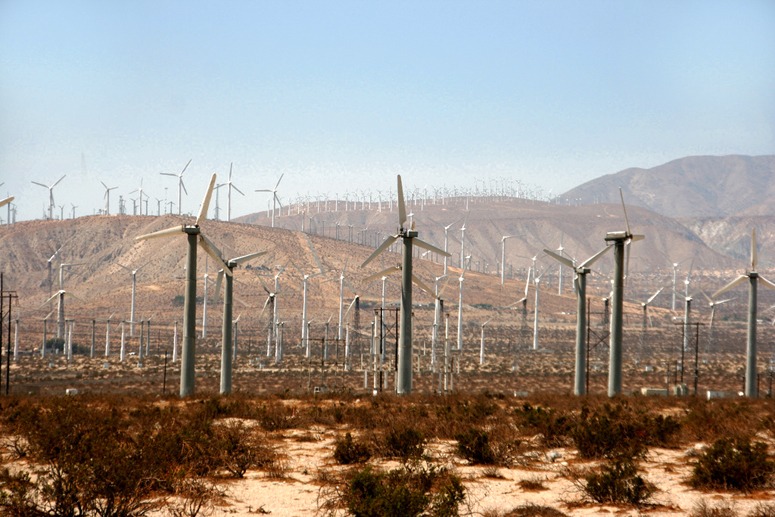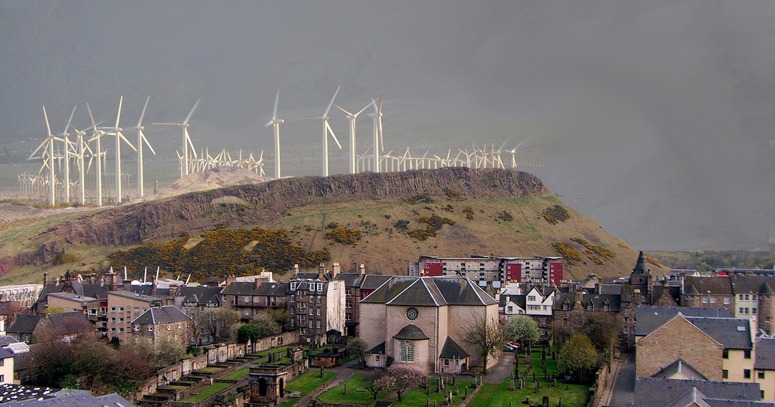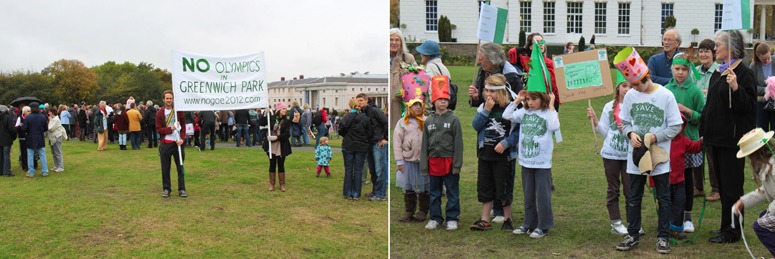We have begun updating the list of 100 Best Books on Landscape Architecture and would be pleased to have suggestions for additions – since it has does not yet have 100 books. There are overlaps with garden design, urban design, architecture and planning. For the convenience of second hand book buyers we have added links to the Abebooks website (from which books can be ordered and delivered to any country). What are your favourite books?
Yearly Archives: 2009
Upland Britain with a blanket cover of wind turbines
David MacKay states that onshore wind farms are likely to generate 2W/m2 and offshore wind farms to generate 3W/m2. To supply the UK energy demand of 50kWh/day would therefore require an area twice the size of Wales to meet the demand with from offshore farms and three times the size of Wales to meet the demand from onshore wind farms. Wales (8,022 sq mi ) has approx 8% of the area of the UK. At present 13.5% of the UK is urbanized. David MacKay asks ‘would the public accept and pay for such extreme arrangements?’ Please study the above photo of Palm Springs in California before giving an answer. Some people might find a blanket of turbines ugly.
Scotland has 32% of the UK’s land area and only 8.4% of the population, so it would be relatively easy to win a democratic vote to blanket Scotland with wind turbines and solve the UK’s energy problem, though the cost would be high. We could omit the Forth-Clyde Valley and include parts of Northumberland and Central Wales in the interests of ‘equity’. Too many southerners have holiday homes in the Lake District for this area to be included – so it could be a good place for property investment.
Above image courtesy slworking
Fine Art, Frieze Art and Landscape Architecture
Thinking, sometimes, that landscape designers can turn to artists, much as we turn to engineers and ecologists, for specialist inspiration on projects, I went to the Frieze Art Fair this afternoon. By way of a review: I found about 2% of the exhibits wonderful and 40% of them trash. Judging from the way other visitors were pacing up and down the aisles, I suspect this opinion is common. Fortunately, we visitors were in disagreement as to which works of art fell into which category. I came away with some design ideas but, better than that, I stopped on the way home to buy a box of Liquitex Heavy Body Acrylic Color. I did not bang into any celebs, unless you count the blue statue of Norman Foster. He can be seen on the video and on this webpage. I was very impressed by the high style in which most visitors were dressed – but instead of high style bikes outside there was a fleet of sinister Black Series 7 BMWs labelled ‘Frieze art 2009 VIP transport’. Trust me, life is better on a Brompton.
London 2012 Olympic Village: Landscape & Garden
 Here is a CGI image of London’s 2012 Olympic ‘Village’ flanked by photos of the Student ‘Village’ it is replacing. One regrets that the Trade Descriptions Act does not apply to the word ‘Village’. The Online Etymological Dictionary entry for Village has: “late 14c., “inhabited place larger than a hamlet but smaller than a town,” from O.Fr. village “houses and other buildings in a group” (usually smaller than a town), from L. villaticum “farmstead” (with outbuildings), noun use of neut. sing. of villaticus “having to do with a farmstead or villa,” from villa “country house” (see villa)” with Villa coming from from PIE *weik- “clan” (cf. Skt. vesah “house,” vit “dwelling, house, settlement;” Avestan vis “house, village, clan;”
Here is a CGI image of London’s 2012 Olympic ‘Village’ flanked by photos of the Student ‘Village’ it is replacing. One regrets that the Trade Descriptions Act does not apply to the word ‘Village’. The Online Etymological Dictionary entry for Village has: “late 14c., “inhabited place larger than a hamlet but smaller than a town,” from O.Fr. village “houses and other buildings in a group” (usually smaller than a town), from L. villaticum “farmstead” (with outbuildings), noun use of neut. sing. of villaticus “having to do with a farmstead or villa,” from villa “country house” (see villa)” with Villa coming from from PIE *weik- “clan” (cf. Skt. vesah “house,” vit “dwelling, house, settlement;” Avestan vis “house, village, clan;”
So “village” is one of our most ancient words and it should mean a group of dwellings occupied by people who are related to each other and who relate to the surrounding land. The design for the London 2012 Olympic Village looks as though it might be in the valley of the Yellow River, providing modern blocks for groups of workers who no longer have any cultural or horticultural connection to the land on which they live. Where are the sustainable green roofs on the Olympic ‘Village’? Or do they plan to build a new Pruitt-Igoe in London?
Death of modernism: the human story
 The Demolition of Pruitt-Igoe in St Louis is identified (following Charles Jencks) as the moment when Modernism in architecture died. Architects are the bad guys in this story.[ http://affordablehousinginstitute.org/blogs/us/2009/07/big-bad-blocks-part-1-blame-the-architects.html ]
The Demolition of Pruitt-Igoe in St Louis is identified (following Charles Jencks) as the moment when Modernism in architecture died. Architects are the bad guys in this story.[ http://affordablehousinginstitute.org/blogs/us/2009/07/big-bad-blocks-part-1-blame-the-architects.html ]
And viewing the following sequence of the Pruitt-Igoe demolition in the film Koyaanisqatsi it is not difficult to follow the popular sentiment.[ http://www.youtube.com/watch?v=7ZF1e24FPpo ] Music by Philip Glass.
However, the world we sometimes do acknowledge, is a complex place…
Christine Wonoseputro contextualises the ‘moment’ in theoretical terms within the history of architecture as art.
Yet the memoirs of a medical student and his wife a nurse “in a 9 story large reddish-tan brick building in the Pruitt-Igoe city housing at 1300 S. 14th” presents quite another picture of the development as it was when first completed and occupied (and imagined). In Urban Design: a typology by Jon T Lang (2005) Pruitt-Igoe is described as the first racially integrated public housing development in St Louis. (p181)
Not the slum – it was to become – usually associated with the legend.[ http://gagronert.com/chapter6.htm ]
It is said that the residential mix of the development “overwhelmingly welfare dependent single mothers” (p182) was not the household mix that had been expected when the complex was designed.
The couple in question occupied their flat for only a year. I assume this was the duration he was working at the St Louis hospital? From a landscape persepctive it is worth asking – what happened to the rivers of trees?
The architect is said to have lamented “I never thought people were that destructive.”
Mass protest against Greenwich Park equestrian event
We like to be first with the news. This photo was taken half an hour ago and we estimate there were over a thousand people in Greenwich Park on a wet afternoon, most of them horrified at the prospect of the damage the Olympic Equestrian Event would do to the Park. Those pounding hoofs and crowds of people would damage the Le Notre Parterre and endanger those wonderful old chestnut trees which do so much to feed Chinese chestnut pickers each autumn. See also: Restoration after 2012 Greenwich Olympic Equestrian Event and Olympic Village 2012.



